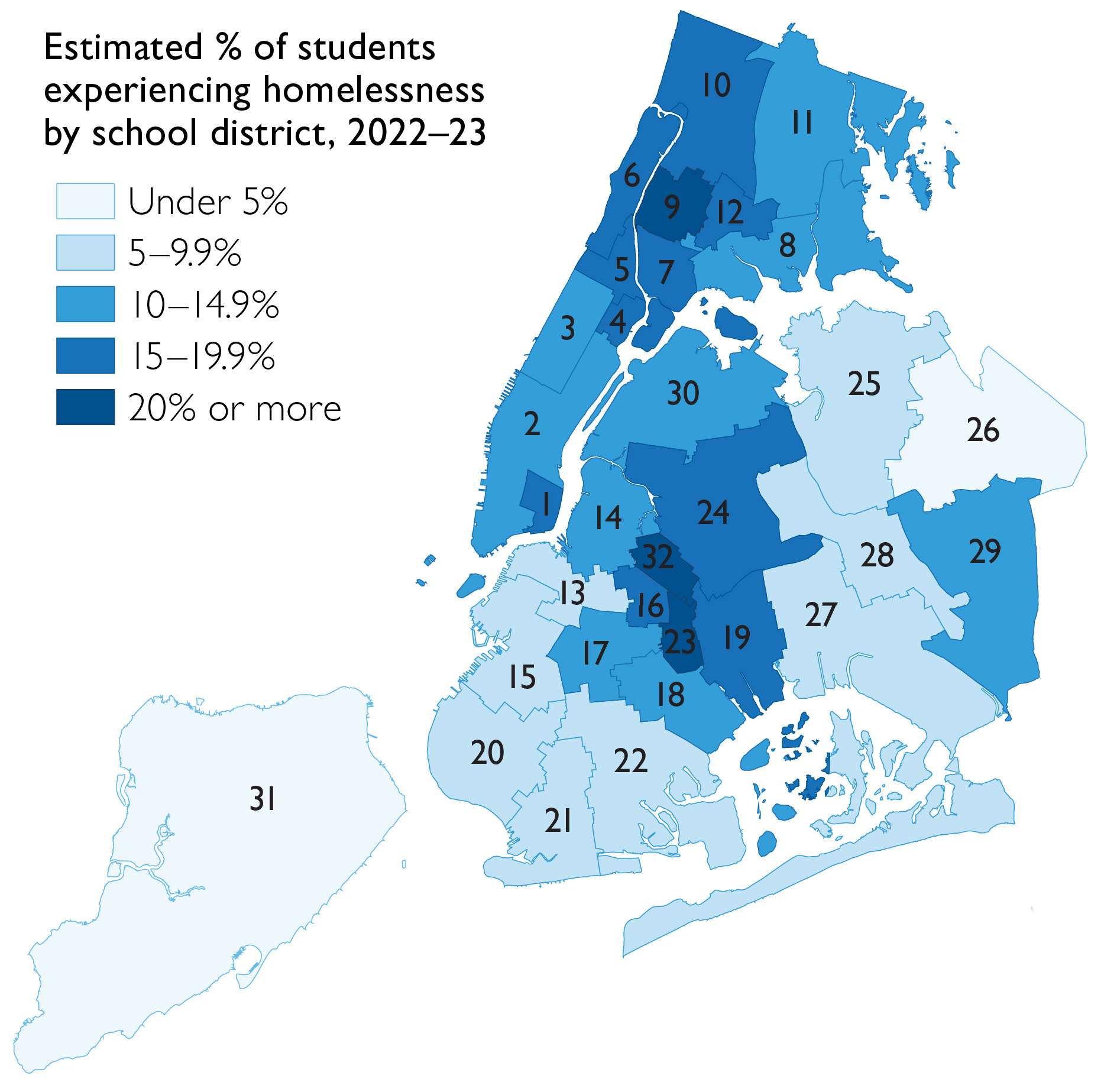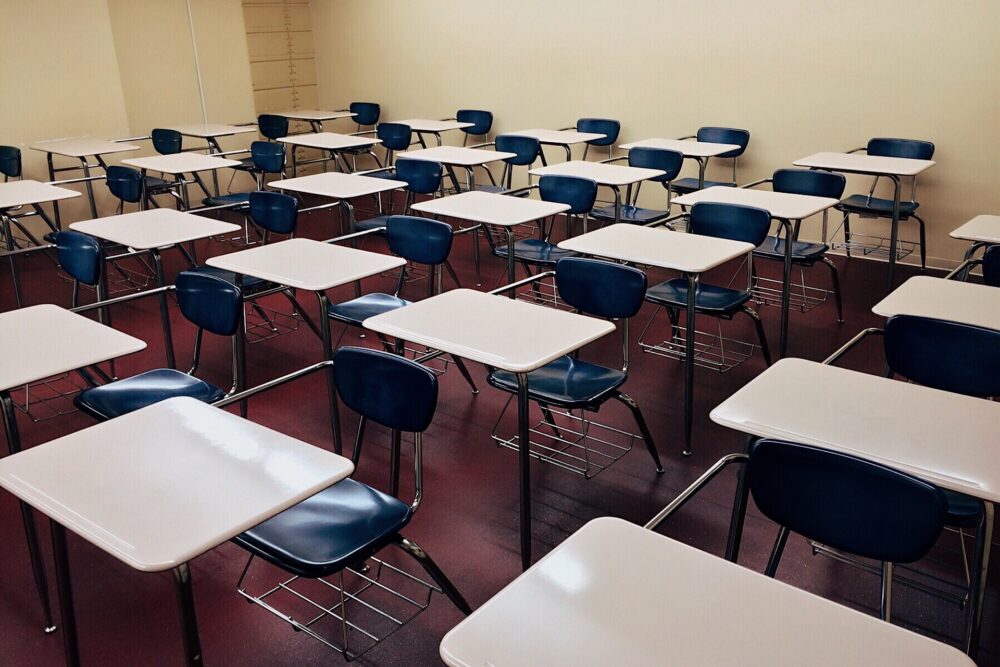Student Homelessness in New York City, 2022–23
More than 119,000 NYC students—roughly one in nine—experienced homelessness during the 2022–23 school year, the eighth consecutive year in which more than 100,000 public school students were identified as homeless.

Data released by Advocates for Children of New York (AFC) show that 119,320 New York City students—roughly one in nine—experienced homelessness during the 2022–23 school year. While the recent increase in the number of immigrant families arriving in New York City has brought greater public attention to the issue, student homelessness is not a new phenomenon: 2022–23 marked the eighth consecutive year in which more than 100,000 public school students were identified as homeless.

The new data, obtained from the New York State Education Department by AFC, show that, of the more than 119,000 students in temporary housing last year, 40,840 (34%) spent time living in City shelters; more than 72,500 (61%) were “doubled up,” or temporarily sharing the housing of others due to loss of housing or economic hardship; and about 5,900 were living in hotels or motels, unsheltered, or otherwise lacking a regular and adequate nighttime residence. While the number and percentage of students without permanent housing rose across all five boroughs, relative to the 2021–22 school year, the highest rate of student homelessness continued to be in the Bronx, where approximately one in every six students was homeless in 2022–23. Districts 4 (East Harlem) and 23 (Brownsville) also had notable concentrations; in both districts, about one in ten students spent time in shelter last year.

Students who are homeless, and especially those living in shelter, face tremendous obstacles to success in school. For example, in 2021–22 (the most recent year for which data are available), students living in shelter dropped out of high school at more than three times the rate of their permanently housed peers, only 22% of those in grades 3–8 reached proficiency on the State English Language Arts (ELA) exam, and 72% were chronically absent, meaning they missed at least one out of every ten school days.
Yet, services that have been put in place to help support these students are under threat, and the situation is becoming more dire as the supports that do exist are stretched thin.
Last year, to help resolve barriers to school attendance and improve educational outcomes for students experiencing homelessness, New York City Public Schools (NYCPS) hired 100 Community Coordinators to work on the ground in shelters. These Coordinators have helped students and families in shelter connect with needed educational services and supports, including helping newly arrived immigrant students enroll in school. However, the Coordinators were hired using temporary funds that will run out in less than a year, and the City has put forward no plan for ensuring the continuity of the position.
“No child in New York City should be homeless, but until we reach that goal, access to a quality education is our best possible tool for ensuring those living in shelter don’t re-enter the system as adults.”
Kim Sweet, AFC’s Executive Director.
“Losing the shelter-based Community Coordinators would almost certainly increase the already sky-high rates of chronic absenteeism and make it even more difficult for students in shelter to succeed in school. The City should be increasing shelter-based public school staff to meet the tremendous need—and at the very least needs a plan to sustain these critical positions,” said Sweet.
Meanwhile, more than one hundred new shelters have opened without any new NYCPS staff to support them. To help meet the need, NYCPS is ready to onboard more than a dozen temporary staff using federal funding that can only be used to support students in temporary housing and must be returned to Washington if not used by next October. However, the City has not yet given the approval for these staff to start due to new budgeting and hiring restrictions.
This holdup is particularly problematic given the City’s new policy of using 28-day hotel placements and limiting shelter stays to 60 days for certain newcomer families, which will cause unnecessary disruption in children’s education—especially with insufficient NYCPS staff to help families navigate their school options and arrange for transportation.
“While students who move to a new shelter placement have the right to stay in their original school, we know from our experience working with families that this is often a right in name only,” said Jennifer Pringle, director of AFC’s Learners in Temporary Housing project.
“Between delays in arranging busing, a shortage of bus drivers, unreasonably long commute times, and other obstacles, parents often feel they have no choice but to uproot their children from schools they love when they move shelters.”
Jennifer Pringle, director of AFC’s Learners in Temporary Housing project
“It’s absurd that the City hasn’t given the green light to onboard staff who are already paid for with time-limited federal funds and who can help support students and families,” said Pringle.
-
View the press release as a PDF
November 1, 2023
Media Coverage
-
A Record 119,300 New York City Students Were Homeless Last Year
-
One in nine NYC students was homeless last year, analysis says
-
Influx of asylum seekers pushes NYC’s homeless student population to record high
-
Migrant surge fuels record number of homeless NYC students

